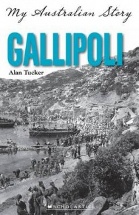Gallipoli by Alan Tucker

My Australian Story. Scholastic, 2013. ISBN 978 1 74283 693 5.
(Age: 11+) Recommended. World War One. ANZAC. Historical.
Diary. I began to read this book with some trepidation as I
have read some 30 books for children and young adults concerning war
and particularly Anzac over the past twelve months, as the centenary
anniversaries of the beginning of World War One and the Anzac
landing approach in 2014 and 2015 respectively. I was not
disappointed as Tucker's story in the My Australian Story series
deals with Anzac through the eyes of a young man of fourteen which
will appeal to the middle school reader, and along the way allow
them to ingest many details about the whole campaign.
Moonta boy, Victor is eager to enlist when war breaks out and with
his parents' permission travels to Adelaide, passing the test due to
his strength and fitness. Camped at Morphetville he describes the
training and new friends in his diary, eager to go to France to
fight, although disquiet is apparent with news that his family
friend, Hans, has been taken to Torrens Island, the detention
centre, because he is German.
Landed in Egypt his diary describes the tedium of training and not
knowing what is happening, until finally they are packed off into
ships and wait orders to land at Gallipoli, part of the 10th
Battalion of the AIF.
Everyone knows that this day and the subsequent eight months spent
on that peninsula in Turkey were miserable, resulting in over 8000
Australian deaths (and 2700 New Zealand deaths) with an ignominious
withdrawal almost as meticulously planned as the initial landing.
Through Victor's imagined diary we see his growing maturity and
dismay with all that is going on about him, we see death and
disease, the longing for home, the news from the home front, the day
to day boredom punctuated by hard fighting, brutality on both sides,
the comradeship and humour generated by their close living quarters,
and in the end the utter futility of war.
The voice of this young man will keep the readers reading, imagining
what they would do in his place, seeing things afresh from the view
of someone their own age. I was amazed at the amount of detail
Tucker was able to subtly infuse in this tale. Each page I came
across things I had not read before. This book will make an
excellent class set to study the landing and its consequences for
this conflict is seen as a turning point in the nationhood of both
Australia and New Zealand. But have some maps ready, as surprisingly
no map was included, although a most useful glossary and explanatory
notes by Tucker are added at the end.
Fran Knight